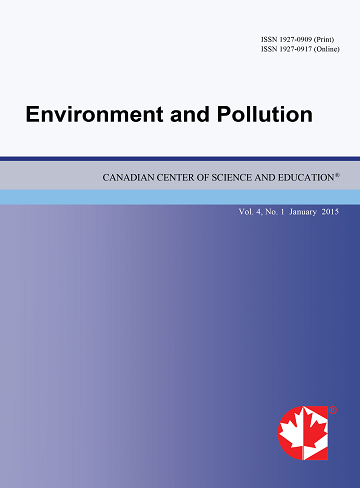Adsorption Efficiency of Flamboyant Pods for Indigo Dye Removal from Textile Industrial Wastewater
- Aderonke Adetutu Okoya
- Doyinsola Omotoyosi Diisu
- Olasunkanmi Olalekan Olaiya
- Oyeyemi Sherifdeen Adegbaju
Abstract
This study investigates flamboyant pods (FP) and chitosan [extracted from periwinkle shells (PS)] modified flamboyant pods (CMFP) adsorbents for dye removal from textile industrial wastewater, and were compared with commercial activated carbon (CAC). Physicochemical properties with dye concentrations of wastewater were investigated before and after adsorption using standard methods and Ultraviolet-visible Spectrophotometer respectively. Batch adsorption were performed and pH (3.0, 4.0, 6.0, 9.0, 11.5), adsorbent dosage (0.1, 0.2, 0.3, 0.4, 0.5 g), contact time (10, 20, 30, 40, 50, 60 minutes) and initial concentration (25, 50, 100, 125, 250 mg/L) were optimized for Indigo dye using the adsorbents. Initial concentration data was used to test conformity with Langmuir and Freundlich adsorption isotherms. Adsorption efficiencies for simulation ranged from 11.33±0.70 to 83.8±0.00. Optimum adsorption conditions of indigo dye were pH 6, 0.1g sorbent dosage, 60 minutes contact time and 250 mg/L dye concentration; gave efficiencies of 83.8%, 79.6% and 89.8% for FP, CMFP, CAC respectively with wastewater. Physicochemical parameters of wastewater decreased except nitrate which increased from 11.53±0.00 to 34.65±1.41mg/L. Data best fit Langmuir than Freundlich adsorption isotherm. The study inferred that FP and PS could be processed as less expensive, environment friendly alternative adsorbent to the costly CAC for treating textile wastewater.
- Full Text:
 PDF
PDF
- DOI:10.5539/ep.v9n2p1
Journal Metrics
Index
- Academic Journals Database
- Berkeley Library
- CAB Abstracts
- CAS (American Chemical Society)
- CNKI Scholar
- COPAC
- CrossRef
- DTU Library
- Elektronische Zeitschriftenbibliothek (EZB)
- EuroPub Database
- Excellence in Research for Australia (ERA)
- Genamics JournalSeek
- Google Scholar
- Harvard Library
- Infotrieve
- Jisc Library Hub Discover
- JournalGuide
- JournalTOCs
- LOCKSS
- Max Planck Institutes
- Mir@bel
- PKP Open Archives Harvester
- Pollution Abstracts
- Publons
- Pubmed journal list
- ROAD
- Scilit
- SHERPA/RoMEO
- Standard Periodical Directory
- Stanford Libraries
- UCR Library
- Ulrich's
- UniCat
- Universe Digital Library
- UoS Library
- WorldCat
- Zeitschriften Daten Bank (ZDB)
Contact
- Albert JohnEditorial Assistant
- ep@ccsenet.org
